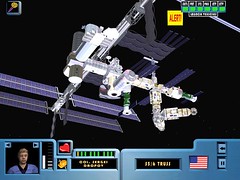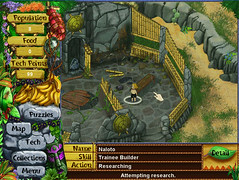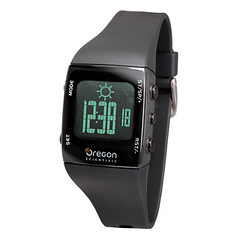Space…. The final frontier… These are the voyages of your own space station, custom built of your imagination using an array of components and modules. Such is the premise of Vision Videogames’ Space Station Sim. Not only design and construction, but also crew selection and management. While this may sound dry to some of you, a space station simulation sounds like music to my simming ears.
 You begin at mission control, where you have a large selection of areas or departments you can visit, ranging from component purchasing to astronaut creation. If you wish to launch a new module for your station, simply go to that department of mission control and select it. Then allocate funding to the construction of the module from various space agencies from around the world and select a launch vehicle. After that, the module is launched and connected to your station in orbit. Then you can outfit your newly launched module with different components. These components come in many categories such as life support and even entertainment (your astronauts get bored up there).
You begin at mission control, where you have a large selection of areas or departments you can visit, ranging from component purchasing to astronaut creation. If you wish to launch a new module for your station, simply go to that department of mission control and select it. Then allocate funding to the construction of the module from various space agencies from around the world and select a launch vehicle. After that, the module is launched and connected to your station in orbit. Then you can outfit your newly launched module with different components. These components come in many categories such as life support and even entertainment (your astronauts get bored up there).
Once in the space station view you can take a peak inside the various modules you have added to your build and select your astronauts for activities. Astronaut management is where the game gets a bit boring for me, as Vision Videogames has gone with a ‘The Sims’ approach to management. Each astronaut has a host of needs and wants. You assign them to various tasks and hope they execute them before deciding they need to use the restroom for the umpteenth time. Personally, I would rather have seen the astronauts as npc’s so I could focus solely on station construction and technical management. Worrying about getting an astronaut their daily workout is not all that appealing to me. Now you don’t technically have to micro-control your astronauts as their AIs should take care of the most pressing issues. However, we found them to be extremely slow and inefficient in responding to situations while in ‘autonomous’ mode.
So, character management is a negative for me. How are the graphics? Well, not so great, but as a simmer I am far more than willing to forgive some bad graphics as long as gameplay is good, which it can be in Space Station Sim. Sound design is fine, with plenty of pre-recorded effects. The score is one of Space Station Sim’s strong points and as has all been recorded or sampled from an assortment of indie artists including Marilyn Rucker and the lovely Julia Othmer.
 How do you keep your station afloat, so to speak? Well, through support of the international community which grants you funding. One of the biggest challenges in Space Station Sim is building an assortment of modules and funding them from a variety of agencies. This increases support from those agencies and their respective countries as does performing experiments in science modules. The more support you have, the more funding. Support is denoted by how many ‘flags’ a country has next to it. More flags, more fun (sorry, hate that commercial)! Once all five countries have 999 flags attributed to them, you win the game and can quit or continue on at your discretion.
How do you keep your station afloat, so to speak? Well, through support of the international community which grants you funding. One of the biggest challenges in Space Station Sim is building an assortment of modules and funding them from a variety of agencies. This increases support from those agencies and their respective countries as does performing experiments in science modules. The more support you have, the more funding. Support is denoted by how many ‘flags’ a country has next to it. More flags, more fun (sorry, hate that commercial)! Once all five countries have 999 flags attributed to them, you win the game and can quit or continue on at your discretion.
Overall, Space Station Sim has some fun moments. However, Vision Videogames has made some poor choices which muddle the experience down in astronaut drama.
You can find the official Space Station Sim website here.

 In fact, your first order of business in the game is to gather more good eats for your people. Villagers move around with their own agendas but that usually doesn’t get you very far. They need a guiding hand to get them to where they need to be and that hand is you! Simply click-and-drag a villager to place them where you like. When you hover them over something useful to them, a message will appear at the bottom of the screen. In the first area of Isola (the island you inhabit), you have to hover a villager over a torch near a bee hive and drop him there. The villager will grab the torch, walk over to a fire and light it – then return to the bees and smoke them calm so you can extract the honey, increasing your tribe’s food supply.
In fact, your first order of business in the game is to gather more good eats for your people. Villagers move around with their own agendas but that usually doesn’t get you very far. They need a guiding hand to get them to where they need to be and that hand is you! Simply click-and-drag a villager to place them where you like. When you hover them over something useful to them, a message will appear at the bottom of the screen. In the first area of Isola (the island you inhabit), you have to hover a villager over a torch near a bee hive and drop him there. The villager will grab the torch, walk over to a fire and light it – then return to the bees and smoke them calm so you can extract the honey, increasing your tribe’s food supply. Overall, the game is alot of fun but way more in-depth than one assumes it will be when you first sit down to it. The graphics are 2D and, while vibrant, are not exceptionally clear or high resolution. Playing in full screen mode on my 1920×1200 LCD just looks horrible, so I played it mostly in windowed mode. Sound is minimal and there is an average score to the game which sounds like a royalty free track. Even with these shortcomings however, the gameplay is a lot of fun and makes for an interesting puzzler as you try to help your villagers thrive.
Overall, the game is alot of fun but way more in-depth than one assumes it will be when you first sit down to it. The graphics are 2D and, while vibrant, are not exceptionally clear or high resolution. Playing in full screen mode on my 1920×1200 LCD just looks horrible, so I played it mostly in windowed mode. Sound is minimal and there is an average score to the game which sounds like a royalty free track. Even with these shortcomings however, the gameplay is a lot of fun and makes for an interesting puzzler as you try to help your villagers thrive.


 theFunctionality: The Meteo is not just a weather forecasting device. It is also a time piece which is water resistant up to 30 meters, a stopwatch that will time up to 60 hours, and also stores the date and day of the week. It also features a nice backlight button that, when held down, will trigger a ‘locked’ mode in which other button presses on the watch do nothing. This is helpful if, say, you are accident prone like me and bang your watch against a car door. One time I hit it right on the side of the watch and I hear the chime of a button being pressed. I looked down at the watch and the time was still being shown – all thanks to it being locked at the time.
theFunctionality: The Meteo is not just a weather forecasting device. It is also a time piece which is water resistant up to 30 meters, a stopwatch that will time up to 60 hours, and also stores the date and day of the week. It also features a nice backlight button that, when held down, will trigger a ‘locked’ mode in which other button presses on the watch do nothing. This is helpful if, say, you are accident prone like me and bang your watch against a car door. One time I hit it right on the side of the watch and I hear the chime of a button being pressed. I looked down at the watch and the time was still being shown – all thanks to it being locked at the time.


